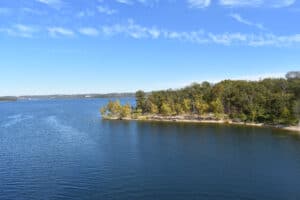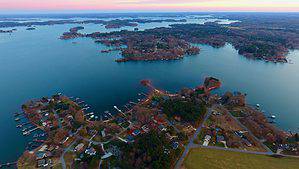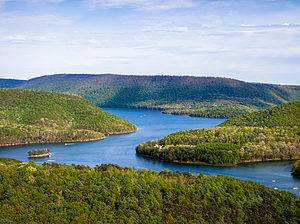Priest Lake in Idaho is a pristine lake in the deep wilderness of the north. It’s a local getaway with tons to see and do, plus an interesting history that dates back to the last ice age. Today, we are going to take a look at this lake and learn about its depth, history, geology, and fishing, plus a lot more. Let’s get started!
Location
Priest Lake is a beautiful lake in the northernmost part of Idaho, United States. The area in Idaho where it is located is called the “panhandle” and is a large thin section of the state that extends north, sharing a border with Canada, Washington, and Montana. It is located in Bonner County, about 80 miles northeast of the relatively large city of Spokane, Washington. The lake is very close to the Canada–US border, with the closest part getting within 15 miles of it.
Priest Lake is surrounded by the Selkirk Mountains, giving it two things: absolutely incredible views and some fantastic ecology (flora and fauna). The lake is part of the Priest Lake State Park, which covers a total of 755 acres of land separated into three campgrounds: Dickenseet, Indian Creek, and Lionhead.
Priest Lake is divided into two parts: the lower Priest and the upper Priest. The lower Priest is the main part of the lake and is 19 miles long in some places. The upper Priest is connected to the lower Priest by a 2.5-mile channel called the “Thoroughfare”. The upper Priest is smaller and shallower than the lower Priest, but as a result, it’s a lot quieter and some say, more pristine.
History
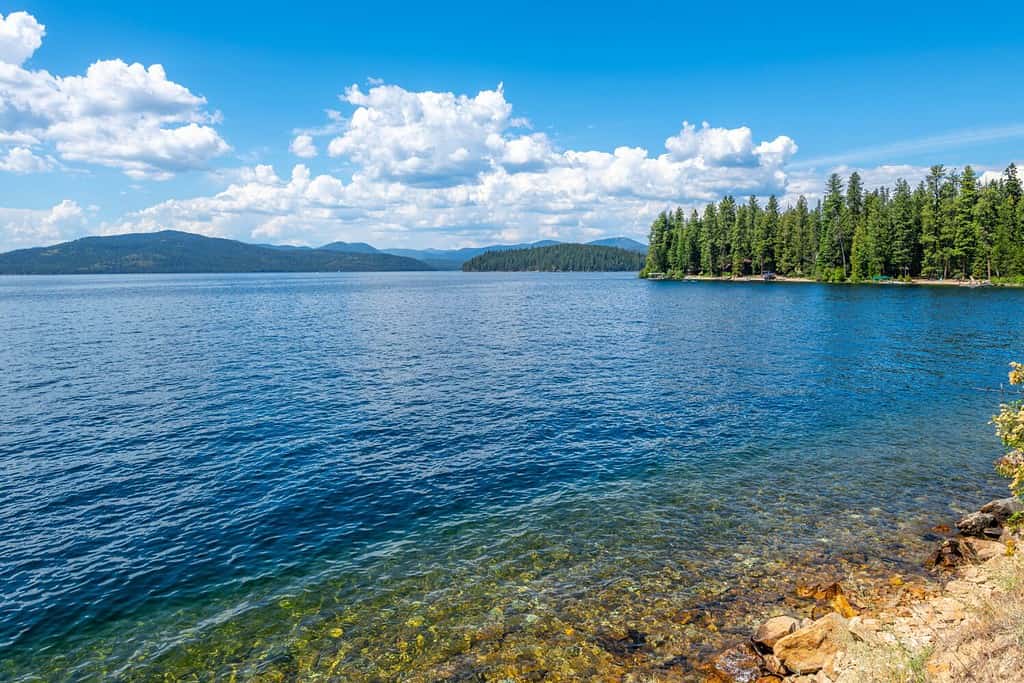
A “glacial lake”, Priest Lake was formed when glaciers carved out rock and then melted as they receded.
©Kirk Fisher/Shutterstock.com
Priest Lake has a history that began a few thousand years ago (at least as far as humans are concerned). The lake was home to the Kalispel tribe, who called it Kaniksu, meaning “black robe,” after the Jesuit priests who visited them in the 19th century. The lake was also explored by fur traders, miners, and loggers, three common occupations for the northern country in this part of the world at that time.
One of these priests was Pierre-Jean DeSmet, who worked with the Kalispel tribe along the nearby Pend Oreille River. He named the lake Roothaan Lake for one of his superiors in Rome, but the name never really stuck. By 1865, Captain John Mullan renamed the lake once again to Kaniksu while he was building a road through the area from Walla Walla in Washington to Fort Benton in Montana. During the construction, however, silver was found in the mountains nearby. The resulting influx of miners created infrastructure, and soon, the area around Priest Lake began developing.
Over the years, Priest Lake became a popular stopover for tourists and people who lived in the area. Recently, resorts, cabins, and campsites were established around the lake, and a thriving tourism industry has sprung up despite the region’s remoteness.
Unfortunately, there have been some fires recently that have impacted Preist Lake and the greater area. Road closures have been common, including closures on the Sandpoint Rangers District, the Coeur d’Alene River Ranger District, and regarding Priest Lake, the Priest Lake Ranger District. The most recent notable fires include the Buckskin II Fire, the Ridge Creek Fire, and the Consalus Fire.
Size
Priest Lake is a large lake in Idaho, with a surface area of about 12 mi². The lake is divided into two parts: the lower Priest and the upper Priest. The lower Priest is the “main” lake, which is 19 miles long and 4.4 miles wide at its widest point. The lower Priest has a maximum depth of 369 feet and a surface elevation of 2,439 feet. The two large sections of lake are connected by a channel named the “Thoroughfare”, which is about 2.5 miles long. The upper Priest is quite a bit shallower than the lower Priest and doesn’t enjoy the same level of popularity that the lower Priest does.
In total, Priest Lake has over 80 miles of shoreline, most of which is surrounded by state and national forests. It’s fed through several primary inflows. The most important one is the Priest River, which flows from the Upper Priest Lake into the Lower Priest Lake at the northern end. Some of the other notable inflows include Indian Creek, Lion Creek, and Hunt Creek, which all enter the lake from different points.
Depth
Priest Lake is an extremely deep lake in Idaho that has a maximum depth of 369 feet.
Priest Lake’s depth affects its water temperature, clarity, and fish habitat. The lake has a thermocline, which is a layer of water where the temperature changes rapidly with depth. The thermocline separates the warmer surface water from the colder bottom water, and it usually occurs between 30 and 60 feet deep. The lake’s water is extremely clear thanks to the “the high Selkirk peaks” that feed it. The lake’s depth also provides a suitable environment for various fish species, especially lake trout since they need very cold and deep water to thrive.
Fishing
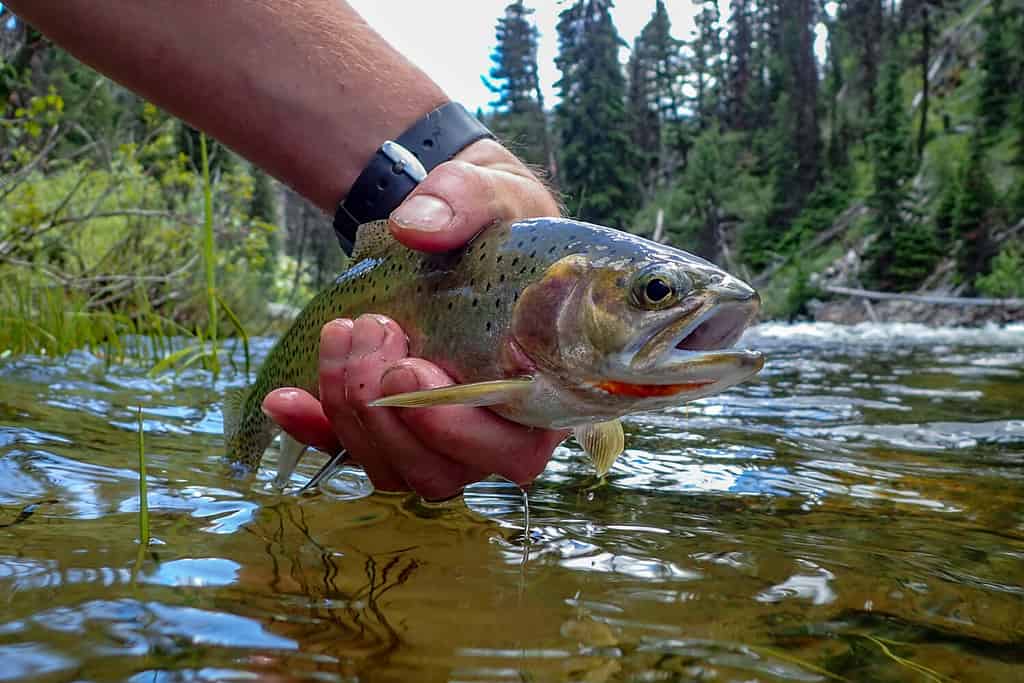
Cutthroat trout are one of the unique species that live in Priest Lake.
©CSNafzger/Shutterstock.com
Priest Lake is easily one of the best fishing locations for anglers looking for some unique catches in the area. Whether you are looking for trophy-sized lake trout, native cutthroat trout, or kokanee salmon, you can find them in Priest Lake. In fact, the largest lake trout ever caught in the U.S. was caught in Priest Lake (it was caught in 1971 and weighed a whopping 57 lbs. 8 oz!). It is important to note that it is ILLEGAL to harvest cutthroat trout from Priest Lake.
Priest Lake is open year-round for fishing. Here are the harvest limits:
- Bass: You can catch up to 6 bass daily, including largemouth and smallmouth bass.
- Brook Trout: You can catch up to 25 brook trout per day.
- Bull Trout: You cannot keep any bull trout, as they are endangered and protected. You must release them immediately if you catch them.
- Burbot: You can catch up to 6 burbot per day.
- Chinook Salmon: You can catch up to 2 chinook salmon per day, but none under 20 inches long.
- Kokanee: You can catch up to 15 kokanee per day.
- Sturgeon: You cannot fish for or target sturgeon in the Kootenai River, as they are also endangered and protected. You must release them immediately if you catch them.
- Tiger Muskie: You can catch up to 2 tiger muskie per day, but none under 40 inches long.
- Trout: You can catch up to 6 trout per day, including any combination of brown trout, golden trout, lake trout, rainbow trout, splake, arctic grayling, and trout hybrids (such as tiger trout). This does not include bull trout and brook trout, which are listed separately.
- Whitefish: You can catch up to 25 whitefish per day.
- All Other Fish Species: There is no limit for any other fish species
Cutthroat trout are native to Priest Lake and can be found in both the lower and upper lakes. They are usually found near the shorelines, especially where there are streams or springs.
Geology
Geology Priest Lake is what’s known as “glacial lake” and was formed by the movement of huge glacial ice sheets during the last ice age. This period, known as the Pleistocene epoch, began about 2 million years ago and lasted until around 10,000 years ago. The lake lies in a valley that was essentially carved by the ice and filled with meltwater as the glaciers went back north. The lake is surrounded by the Selkirk Mountains a range within the Columbia Mountain range.
Camping, Boating, and Activities
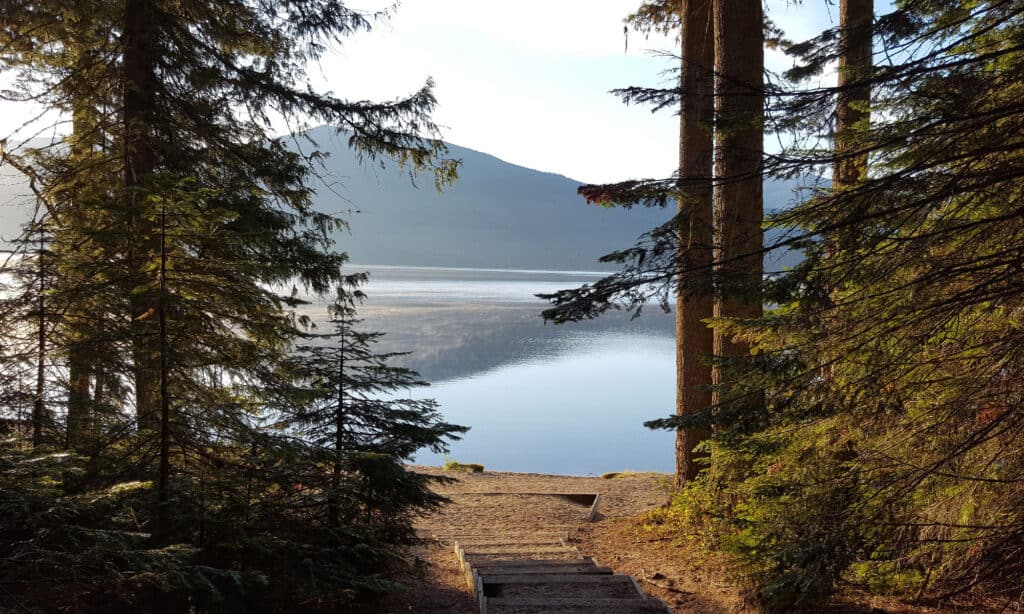
Priest Lake is great for year-round lake trout and also an ideal environment for winter water and outdoor recreational activities such as cross-country skiing, snowshoeing, and snowmobiling.
©APete/Shutterstock.com
There is pretty much no end to the activities you can do at Priest Lake. Besides the basic things you can do at most lakes (swimming and playing in the water), Priest Lake also offers:
- Camping
- Boating (both motorized and non-motorized)
- Fishing (as we’ve covered)
- Hiking
- Biking
- Nature viewing (there is even a small population of grizzly bears that live nearby)
- Seasonal festivals
- Snowmobiling
- Snowshoeing
- Cross country skiing
- Sports
- And a whole lot more.
Additionally, the lower Priest is pretty developed. There are grocery stores, food stands, restaraunts, rentals, and pretty much all the ameneties you could need. Whether you want to “rough” it and head out into the wilderness or stay in a beautiful yurt or special cabin, you can pretty much do it all from Priest Lake.
The photo featured at the top of this post is © iStock.com/Jennifer Davis
Thank you for reading! Have some feedback for us? Contact the AZ Animals editorial team.




